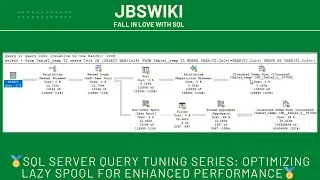SQL Server Query Tuning Series: Boost Performance by Avoiding DISTINCT
на канале: JBSWiki
SQL Server Query Tuning Series: Boost Performance by Avoiding DISTINCT @TuningSQL @jbswiki
Introduction to SQL Server Query Tuning 🧠
In the ever-evolving landscape of data management, SQL Server remains a cornerstone for many organizations. Ensuring optimal performance of your SQL queries is paramount for efficient data retrieval and processing. One common yet often misunderstood aspect of query optimization involves the use of the DISTINCT keyword. In this comprehensive guide, we'll explore why avoiding DISTINCT can lead to significant performance improvements and provide practical strategies for achieving the same results without it. Let's dive into the intricacies of query tuning and unlock the full potential of your SQL Server! 🔧✨
Understanding the DISTINCT Keyword 🔍
What is DISTINCT? ❓
The DISTINCT keyword is used in SQL to remove duplicate rows from a result set. It ensures that the returned data contains only unique records. While DISTINCT can be incredibly useful, it can also lead to performance bottlenecks if not used judiciously.
Example of DISTINCT Usage 📘
sql
Copy code
SELECT DISTINCT ColumnName FROM TableName;
This query retrieves unique values from ColumnName in TableName.
Performance Implications of Using DISTINCT ⚡
Increased CPU Usage 🖥️
When SQL Server processes a query with DISTINCT, it must perform additional work to identify and eliminate duplicate rows. This involves sorting and comparing the data, which can be computationally expensive, especially for large datasets.
Impact on Memory Usage 🧠
Sorting large result sets requires significant memory. If the available memory is insufficient, SQL Server may spill data to disk, further degrading performance.
Execution Plan Complexity 📈
Queries with DISTINCT can lead to more complex execution plans. This complexity can result in slower query performance and increased resource consumption.
Identifying When to Avoid DISTINCT 🚫
Redundant Use of DISTINCT 🗑️
Sometimes, DISTINCT is used unnecessarily. For example, if the query already retrieves unique records due to the nature of the data or existing constraints, using DISTINCT adds redundant overhead.
Better Alternatives to DISTINCT 🔄
In many cases, there are more efficient ways to achieve the desired results without using DISTINCT. Let's explore these alternatives in detail.
Alternatives to DISTINCT for Optimal Performance 🌟
Using GROUP BY 📊
The GROUP BY clause groups rows that have the same values in specified columns into aggregate data. It can often replace DISTINCT and provide better performance.
Example:
sql
Copy code
SELECT ColumnName FROM TableName GROUP BY ColumnName;
This query achieves the same result as SELECT DISTINCT ColumnName FROM TableName; but can be more efficient.
Utilizing EXISTS for Subqueries 📜
The EXISTS keyword checks for the existence of rows in a subquery. It can be a powerful alternative to DISTINCT in certain scenarios.
Example:
sql
Copy code
SELECT ColumnName FROM TableName WHERE EXISTS (SELECT 1 FROM AnotherTable WHERE Condition);
Leveraging Window Functions 📐
Window functions, such as ROW_NUMBER(), can help eliminate duplicates without using DISTINCT.
Example:
sql
Copy code
SELECT ColumnName
FROM (
SELECT ColumnName,
ROW_NUMBER() OVER (PARTITION BY ColumnName ORDER BY (SELECT NULL)) AS RowNum
FROM TableName
) AS SubQuery
WHERE RowNum = 1;
Best Practices for Avoiding DISTINCT 🌟
Proper Indexing 📈
Indexes play a crucial role in optimizing query performance. Properly indexed columns can eliminate the need for DISTINCT by ensuring faster data retrieval and unique record selection.
Data Normalization 🔧
Normalization involves organizing data to reduce redundancy and improve integrity. Properly normalized tables often negate the need for DISTINCT by inherently maintaining uniqueness.
Query Analysis and Refactoring 🛠️
Regularly analyzing and refactoring your queries can help identify and eliminate unnecessary use of DISTINCT. Use tools like SQL Server Profiler and Execution Plan Analyzer to pinpoint performance issues.
Real-World Examples and Case Studies 🌍
Case Study 1: Removing DISTINCT for Faster Report Generation 📊
Scenario: A company experienced slow performance in generating sales reports due to the use of DISTINCT in multiple queries.
Solution:
Analysis: Identified redundant use of DISTINCT.
Refactoring: Replaced DISTINCT with GROUP BY and optimized indexes.
Result: Query execution time reduced by 60%, and overall report generation became significantly faster.
Case Study 2: Optimizing Data Retrieval in a Web Application 🌐
Scenario: A web application faced slow page loads due to heavy use of DISTINCT in its database queries.
Solution:
Investigation: Analyzed the execution plans and identified the DISTINCT bottlenecks.
Implementation: Replaced DISTINCT with window functions and EXISTS subqueries where applicable.
Result: Page load times improved, enhancing the user experience and reducing server load.































